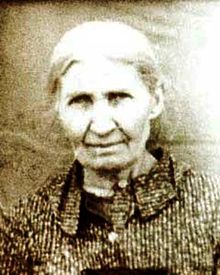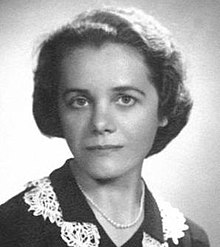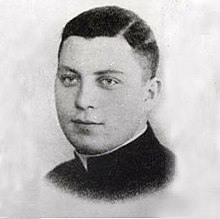In 1999, Pope John Paul II returned to Poland for his eighth papal visit to his home country. While he was in Poland, he beatified 108 martyrs in Warsaw.
Do you know about their incredible stories of sacrifice and bravery?
The group of martyrs includes three bishops, fifty-two priests, twenty-six religious brothers, three seminarians, eight religious sisters, and nine lay people.
“If we rejoice today for the beatification of one hundred and eight martyrs, clergy and lay people, we do so above all because they bear witness to the victory of Christ, the gift which restores hope,” Pope John Paul II said in his homily during the beatification Mass. “The blessed martyrs cry to our hearts: Believe in God who is love! Believe in him in good times and bad! Awaken hope! May it produce in you the fruit of fidelity to God in every trial!”
Here are just a few of their incredible stories:
1. Blessed Marianna Biernacka

In 1943, Nazi soldiers arrested Marianna’s son, Stanislaw, and his wife, Anna. To retaliate for the death of German soldiers in a nearby village, the soldiers decided to shoot Stanislaw and Anna.
When Marianna saw her son and daughter-in-law pulled from the crowd, she offered to take the place of her pregnant daughter-in-law. Nazis held Marianna in prison for two weeks, then killed her on July 13, 1943. Nazi soldiers granted Marianna’s last request to hold onto her Rosary at her execution.
Anna lived to be ninety-eight years old, and her family still lives in Poland.
2. Blessed Natalia Tułasiewicz

Natalia was Polish teacher and lay leader. She is one of only two lay women honored with the 108 martyrs of Poland. During the Nazi occupation of Poland, Natalia and her family were evicted from their home with only a few hours notice.
Natalia volunteered to leave for the Third Reich to support and comfort women forced to perform heavy physical labor. But when the Germans found out about her mission work, they arrested her. Nazi soldiers tortured her and sent her to the Ravensbrück concentration camp.
On Good Friday, Natalie stood up on a stool in the barracks and told her fellow prisoners about the beauty of Christ’s passion and death. She was killed in a gas chamber on Easter Sunday, March 31, 1945. Ravensbrück was liberated two days later.
3. Blessed Bronisław Kostkowski

Bronisław was only twenty-seven years old when he was killed during the Nazi occupation of Poland. He was a Roman Catholic seminarian. Bronisław was first imprisoned in the Nazi Sachsenhausen concentration camp. He later died at the Nazi Dachau concentration camp.
4. Blessed Maria Antonina Kratochwil

Maria entered the Congregation of the School Sisters of Notre Dame in 1901. The organization was dedicated to providing primary, secondary, and post-secondary education. She served as the director for a Catholic boarding school and trained other sisters as teachers.
The Gestapo arrested Sister Maria on July 9, 1942 along with six other religious sisters. While in prison, she advocated for other women and intervened against the brutal treatment of Jewish women prisoners.
Prison guards beat her mercilessly. When she returned to her cell, she couldn’t lie on her back. The religious sisters were released from prison in September 1942, after weeks of harsh interrogations. Sister Maria died from her injuries five days after her release.
5. Blessed Grzegorz Bolesław Frąckowiak

Grzegorz was poor and couldn’t afford to go to high school or the seminary. When he was sixteen years old, he became a missionary brother and was sent to Gorna Grupna, Poland. There he met Aloysius Liguda and Stanisław Kubista, who would also be martyred for the Catholic faith.
He took his final vows in 1930, and authored daily spiritual exercises. When the novitiate was invaded, Grzegorz escaped. He created an editorial called “For you, Poland.” But Germans discovered the editorial and hunted down Grzegorz and his companions. Grzegorz took the blame for the editorial, which allowed for the release of several of his friends. He was beheaded by guillotine in Dresden in 1943.
6. Blessed Michał Piaszczyński

Michael was ordained to the priesthood in 1911. He became a parish priest, and went on to earn a doctorate in philosophy. He also served as the chaplain to a Polish miner colony.
Father Michael was arrested on April 7, 1940 and moved to Sachsenhausen. While he was in prison, Father Michael gave up his own food rations so that elderly Jewish prisoners could have something to eat. He died of physical exhaustion on December 18, 1940.
7. Blessed Ludwik Pius Bartosik

When Ludwik was seventeen, he joined the Order of Friars Minor, taking the name Pius Maria. He was ordained to the priesthood in 1935. Father Pius served as the editor of “Knights of the Immaculate,” working alongside Maximilian Kolbe.
He was arrested alongside Maximilian Kolbe on February 17, 1941. He was abused and beaten in prison, but offered consolation to fellow prisoners.
“So far, we wrote and told others how to endure suffering,” he said while in prison. “Now we have to go through it practically ourselves, or else what would our words be worth?” Called an apostle of suffering, he died in Auschwitz on December 13, 1941.
8. Blessed Antoni Julian Nowowiejski
When Antoni was sixteen, he entered the diocesan seminary. He was ordained to the priesthood on July 10, 1881. He became a professor and rector at the seminary, and later was ordained a bishop in 1908.
During World War I, Antoni initiated a local chapter of Catholic Action. When Germany invaded Poland, one of their goals was to abolish the Polish intelligentsia, which included artists, teachers, and academics.
Antoni had an opportunity to escape, but refused, saying, “How can a pastor abandon their sheep?” Nazi soldiers tortured him when he refused to stomp on his pectoral cross. He spent his time in prison blessing the tortured and dying. He died in 1941 after three months of torture.
9. Blessed Katarzyna Celestyna Faron

When Katarzyna was only five years old, her mother died. At age seventeen, she entered the Congregation of the Sister Servants of the Blessed Virgin Mary, where she took the name Celestyna. As a religious sister, she taught kindergarten.
She was arrested by the Gestapo and eventually sent to Auschwitz. There she suffered from typhoid fever, pulmonary tuberculosis, and recurrent hemorrhages.
While on her deathbed, she prayed for others on a rosary made out of bread crumbs. She offered up her suffering for the conversion of a Catholic bishop, Władysław Faron. The bishop later returned to the Catholic Church.
Celestyna died on Easter Sunday, April 9, 1944.
10. Blessed Józef Cebula

When Józef was a child, he suffered from incurable tuberculosis. He recovered and shared his story with a priest at a local Oblate shrine in Poland. He was encouraged to attend the seminary. After discerning a vocation to the priesthood, he was ordained on June 5, 1927.
Two years after his ordination, Germans invaded Poland. Father Cebula was put under house arrest with about a hundred others in his community. They were later sent to Dachau, where Father Cebula continued to minister as a priest. Nazi soldiers transferred him to Inowroclaw after catching him administering the sacraments.
“It is not you who are in charge. God will judge you,” he told Nazis at the camp. He was then told to run with a heavy rock on his back towards the camp’s barbed wire fence. The guard who shot him to death with a sub-machine gun said that the priest was “shot while trying to escape.”
Blessed martyrs of Poland, pray for us!

Comments